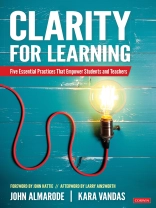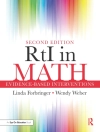AN ESSENTIAL RESOURCE FOR STUDENT AND TEACHER CLARITY
With the ever-changing landscape of education, teachers and leaders often find themselves searching for clarity in a sea of standards, curriculum resources, and competing priorities. Clarity for Learning offers a simple and doable approach to developing clarity and sharing it with students. Are both teachers and students clear about what must be learned, why students are learning it, and how they can be successful? Are students able to determine their next steps in learning through quality feedback and assessment? Have teachers had the time and support to collaborate around clarity to ensure an aligned approach within your school system?
This book offers five powerful practices that include:
- Gaining clarity
- Sharing clarity
- Feedback with clarity
- Assessing with clarity
- Collaborating with clarity
In addition, the book is chock-full of examples from teachers and leaders across North America who have shared their journey, struggles, and successes to provide examples, exemplars, and models for readers to use to propel their own work forward. This is a don’t-miss resource!
Inhaltsverzeichnis
Foreword by John Hattie
Acknowledgments
About the Authors
Introduction
WHY CLARITY?
Chapter 1. The Clarity Problem
What Is the Clarity Problem?
Evidence of the Clarity Problem
Categories of Clarity Problems
Conclusion
Reflection and Next Steps
GAINING CLARITY
Chapter 2. Gaining Clarity: Crafting Learning Intentions and Success Criteria
A Personal Account of Clarity From the World of Education
Learning Intentions
Effective Learning Intentions
Common Questions and Misconceptions About Learning Intentions
Generating Learning Intentions From Content Standards
Success Criteria
Effective Success Criteria
Common Questions and Misconceptions About Success Criteria
Generating Success Criteria
Planning as a Next Step
The Litmus Test
Summarizing Gaining Clarity
Reflection, Next Steps, and Evidence
Chapter 3. Gaining Clarity in Action: Voices From the Field
Voices From the Field
Conclusion
Reflection
SHARING CLARITY
Chapter 4. Sharing Clarity: Co-Constructing Success Criteria With Learners
Why Co-Constructing Matters
What Does Co-Constructing Success Criteria Entail?
Steps to Co-Constructing Success Criteria
Goal Setting and Progress
Common Questions and Misconceptions About Co-Constructing
Reflection, Next Steps, and Evidence
Chapter 5. Sharing Clarity in Action: Voices From the Field
Voices From the Field
Reflection
ASSESSING WITH CLARITY
Chapter 6. Assessing With Clarity: Opportunities to Respond
What Are Opportunities to Respond?
More Than Assessment and Evaluation
Timing the Opportunities to Respond
Characteristics of Opportunities to Respond
Making Thinking Visible
Tasks Versus Exercises
Engaging Scenarios
Conclusion
Reflection and Next Steps
Chapter 7. Assessing With Clarity in Action: Voices From the Field
Voices From the Field
Reflection
FEEDBACK WITH CLARITY
Chapter 8. Feedback With Clarity: Giving and Receiving Feedback on and for Learning
What Is Effective Feedback?
Types of Feedback
The Delivery of the Feedback
Effective Feedback With Effective Delivery
Adjust Feedback for Learners
A Balanced Approach
Reflection and Next Steps
Chapter 9. Feedback With Clarity in Action: Voices From the Field
Voices From the Field
Reflection
CLARITY IN COLLABORATION
Chapter 10. Collaborating for Clarity in Learning
Charting Your Clarity Journey
Charting Next Steps
The Journey Toward Clarity in Barren County Public Schools
What It Takes to Make Clarity Happen
In the Classroom
In the School or District: Collective Teacher Efficacy and Intentionality in Professional Learning
Clarity
Put Them Together
Our Clarity Purpose
Chapter 11. Collaborating for Clarity in Learning: Voices in Action
Voices From the Field
Reflection
Appendix A
Clarity
Learning Intentions
Success Criteria
Learning Progressions
Co-Constructing Success Criteria
Assessment-Capable Learners (ACL)
Opportunities to Respond
Feedback
Collective Teacher Efficacy
Appendix B
Afterword by Larry Ainsworth
References
Index
Über den Autor
Kara Vandas is an educator with an enduring passion for empowering learners. She began her career in education at an alternative school for youth at-risk. Kara spent several more years in the classroom in public education as a middle and high school educator and then transitioned to coaching and professional learning positions that allowed her to support teachers and leaders. Her current role as an author and consultant takes her around the world to partner with schools and school districts. She also presents nationally and internationally at conferences, with a focus on learner agency and efficacy.Kara is the co-author of Partnering with Students: Building Ownership of Learning and holds a Master’s degree of Education in Curriculum and Instruction from Regis University. She has worked in K-12 education for nearly 20 years with a focus in instruction, curriculum design, using data to drive instruction, science education, learning environments, formative assessment, Visible Learning, and more. She also volunteers as a board member at her child’s local school, where she and her family live in Castle Rock, Colorado. She loves the outdoors and spends much of her free time with family and friends.












